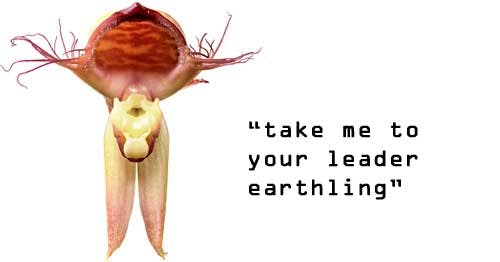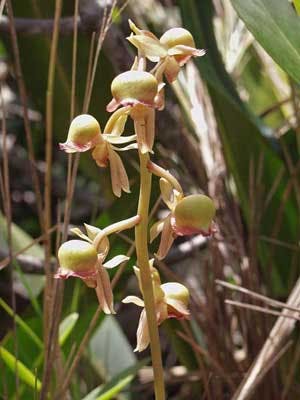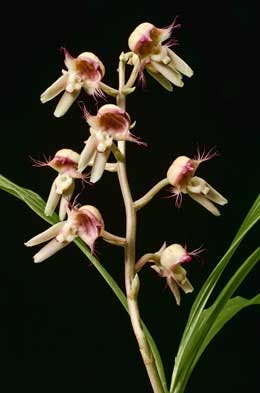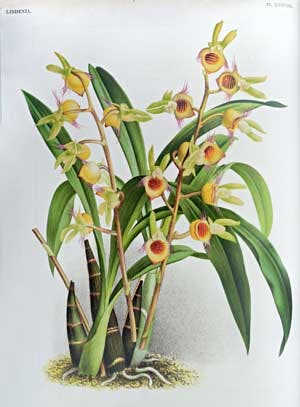
"Little alien visitors with hair-like arms" I thought as I examined the mislabeled Catasetum flowering for the first time. Although I had seen this orchid before, I did not recognize these flowers. The plant I photographed in Venezuela over ten years ago had a toothed edge to the lip but lacked those intriguing hairy protrusions. This plant came from a Brazilian grower at the Redland International Orchid Festival and knowing he usually brings Brazilian species I pulled out Francisco Miranda’s Orchids from the Brazilian Amazon. The opening spread of the second section on "Woodlands of the Central Amazon" featured an excellent full page photo of Catasetum discolor, complete with hairy arms. Miranda goes on to say that the species is variable in color and the distribution of appendages on the labellum. The plant photographed far to the north in the Gran Sabana was growing as a terrestrial in the sandy topsoil whereas Miranda states it can also be found growing epiphytically on palm trees in Brazil. The Venezuelan plant also had considerably larger flowers.

Catasetum discolor photographed in situ - Gran Sabana, Venezuela
Catasetum discolor has a wide range of distribution that includes Guyana, Suriname, Venezuela, Brazil, Colombia and Peru. This wide range explains the variability of the flowers. As is often the case with widely dispersed species, there may be stable “races” existing within certain geographic localities. A photo at Herbarium Jany Renz of a plant photographed in Bolivar State in Venezuela is similar to the plant I saw in 2001 and lacks the extravagant ciliae at the edges of the lip — clearly different from photos of Brazilian plants.
Another characteristic of widely distributed species is their adaptability. Ned Nash would call this a “coyote species” because of its adaptability to a wide range of conditions. These are the opportunistic orchids that are the first colonizers of even marginally suitable areas. Here we have a species that can be found growing on trees, rocks or in the ground, across a wide range of elevations, light levels and precipitation amounts. For orchid hobbyists that translates to an orchid that is easy to grow. If you have never tried growing catasetums before, here is a good one to start with.

The stipe ejected after touching the sensitive spot, positioned to attach itself ostensibly to the thorax or abdomen of the pollinator.
Despite its potential ease of culture, the species does not appear to be popular among US collectors. OrchidPro® shows only one AOS award to the species: Catasetum discolor ‘Nisqually’ CBR/AOS exhibited by Maurice E. Powers and awarded on November 12, 1978 in Portland. A quick search of Flickr shows images from only a dozen or so contributors and half of those are from South America. The flowers of this species are different from other catasetums in more than appearance. They lack the trigger hairs used to eject the pollen that is so common throughout the genus or as Pridgeon says in his Illustrated Encyclopedia of Orchids, "they are poorly developed." That does not seem to put this species at any disadvantage. There is a sensitive "sweet spot" at the base of the opening of the column that when touched, dispatches the two pollinia swiftly and effectively. Judging from its success at growing throughout most of the northern part of South America this adaptation may be even more effective than the antennae typical of other catasetums. This would be an interesting orchid to see being pollinated!

The inflorescence of the plant now in bloom.
After our Cattleya collection was decimated by hurricanes a few years back we started growing catasetums and they have proven to be rugged, easy to grow orchids. Understanding their strictly seasonal growth pattern based on rainfall is key to growing them. They will grow like a cabbage in Alaska during the growing season, and then lose their leaves and spend the winter as dormant, leafless pseudobulbs. Trying to force them to do otherwise will only result in disappointment. Encouraging them to put on maximum growth during the growing season will produce optimum flowering. We grow ours all the same, in plastic pots of sphagnum moss. We tend to use a slightly larger pot than some recommend because we feel that allowing ample room for the ensuing vigorous root development provides strong growths. Plants are grown shady-bright and the media is kept evenly moist. Do not allow it to dry completely. Temperature range is the same for most tropical epiphytic orchids within a range of 50-85º F (10-20º C) however, the plants will withstand near freezing temperatures when leafless. Time release fertilizer is sprinkled on top of the media and they are also fed twice a month during the growing season along with the other orchids. We use a balanced fertilizer or a cal-mag formula. We do not remove plants from their pots in the fall. We simply move them to a dry, bright area of the shadehouse. As plants are coming out of dormancy in the spring we remove them from their pots and pull away old sphagnum and dead roots. Divisions can be made by cutting or breaking off a firm pseudobulb. We then repot the plant and any divisions in fresh sphagnum moss. You may need to use a plant stake to hold pseudobulbs stationary until roots develop. Water left standing in the new growths can easily cause them to rot so do not start watering too early. Wait until the growths are several inches tall and there is root growth to support them. Even then, try to water the pot, not the plant. See Fred Clarke’s excellent culture instructions in the March 2012 issue of ORCHIDS.

Catasetum discolor was not well known in the nine- tenth century either. The text for plate XXXVIII in Lindenia states, “…it is an old plant which remains rare and few enthusiasts have seen it bloom.”
References
- Bechtel, Cribb, Launert 1992. The Manual of Cultivated Orchids. The MIT Press, Cambridge, Massachusetts.
- Linden, J., Linden, Lucien, Rodigas, E.M., Rolfe, R.A 1993. Lindenia. Naturalia. Turriers.
- Pridgeon, Alec, The Illustrated Encyclopedia of Orchids, Timber Press, 1992.
- Website: Internet Orchid Species Photo Encyclopedia - www.orchidspecies.com.
- Website: Swiss Orchid Foundation at the Herbarium Jany Renz - www.orchid.unibas.ch
Greg Allikas, February 2012








